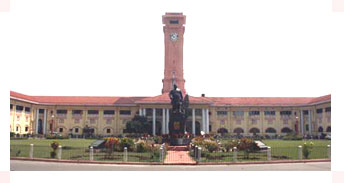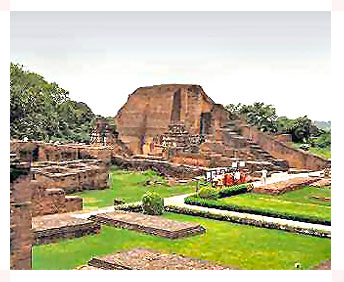When we speak of Bihar we are remembered of ancient India
when Buddhism was evolving into what now is an universal
religion.The
Word "Bihar" has been coined from "Vihara"
meaning Buddhist Monasteries. At one time in the epoch
of history these "viharas" were all strewn
over the landscape of Bihar, around villages and cities
alike.
Patna its capital city today, Patliputra in those
times was home to one of the greatest monarchs in
the history of the world who ruled over much of the
Indian - Subcontinent and extended as far as Iran
and Afghanistan to the West.Bihar is the fascinating
land of great religious leaders like Gautama Buddha,
Lord Mahavir and Guru Gobind Singh.
Bihar is the home of Emperor Ashoka who preached "ahimsa"
or non-violence and spread the message of Buddhism
throughout the world. The tradition of "ahimsa"
has been carried into the modern times and the land
was witness to the "Satyagraha (or non-violence)
Movement" of the Father of the Nation, Mahatama
Gandhi.
Bihar is situated in the eastern part of India with
the Himalayan Kingdom of Nepal to its north and the
 states of Orissa, West Bengal, Uttar Pradesh and Madhya
Pradesh flanking its sides. It is today home of more
than 90 million Indians. The state is endowed with
an enviable mineral resources base, has some of the
finest industries, is country's one of the largest
producers of fruit and the second largest producer
of vegetables. However, this rich state in terms of
natural and human resources and the second most populous
in the country has been slow to harness its natural
and human resources for the development of the state
and its people.
states of Orissa, West Bengal, Uttar Pradesh and Madhya
Pradesh flanking its sides. It is today home of more
than 90 million Indians. The state is endowed with
an enviable mineral resources base, has some of the
finest industries, is country's one of the largest
producers of fruit and the second largest producer
of vegetables. However, this rich state in terms of
natural and human resources and the second most populous
in the country has been slow to harness its natural
and human resources for the development of the state
and its people.
This state which gave the nation the first President
of the Indian Republic, Dr Rajendra Prasad is taking
slow but confident steps to join the mainstream
of economic growth and occupy its rightful place
in the country's economy in the next millenium.
History
The History of Bihar as a region is very rich and
eventful. This is due to the fact that Bihar was a
center of power, learning and culture. It has been
a cradle of Indian civilization and the birth place
of two of the major religions that have emanated from
India: Buddhism and Jainism. Much of the ancient Indian
text written outside of the religious epics have been
written in this ancient land: Arthashashtra and Kamasutra
being the most prominent. The first known republic,
a state without a sovereign king, existed in this
region more than two thousand years back.
Ancient
The central region of what is now known as Bihar was
called Magadha in ancient days. Its capital Patna,
then called Pataliputra, was the capital of the Mauryan
empire which ruled over much of the Indian - Subcontinent
and extended as far as Iran and Afghanistan to the
West. Emperor Ashoka, one of the greatest monarchs
in the history of the world, who ruled between 273
BC and 232 BC was the most famous ruler of the Mauryan
dynasty.
Just north of Magadha across the river Ganges is
the Vaishali region. It is here that the first republic
of the lichchvis was established even before the
Magadha empire reached its peak of glory.
To the north east of Vaishali is Mithila, the kingdom
of the legendary king Janak. Sitamarhi in Mithila
is said to be the birth place of King Ram's queen
Sita.
 Bihar
remained an important place of power for about a
thousand years. Its importance as the centre of
Indian culture and education outlived its importance
as the center of Power by another five hundred years
or so. Out of the three ancient universities of
India, two Nalanda and Vikramshila Universities
were located in Bihar, with third being Taxila in
present day Pakistan. These ancient centres of learning
were destroyed by the maruading early Islamic raiders
around 1200 AD. Bihar
remained an important place of power for about a
thousand years. Its importance as the centre of
Indian culture and education outlived its importance
as the center of Power by another five hundred years
or so. Out of the three ancient universities of
India, two Nalanda and Vikramshila Universities
were located in Bihar, with third being Taxila in
present day Pakistan. These ancient centres of learning
were destroyed by the maruading early Islamic raiders
around 1200 AD.
Bihar is also the birthplace of many religions,
including Buddhism and Jainism. The word "Bihar"
has its origin in the Sanskrit word "Vihara",
meaning Buddhist Monasteries. Buddha attained Enlightenment
at Bodh Gaya, a town located in the modern day district
of Gaya. Buddha started spreading his teaching after
attaining the Enlightenment at Bodh Gaya. Mahavira,
the the 24th Tirthankara of Jainism, was born in
Vaishali, When we speak of Bihar we are remembered
of ancient India when Buddhism was evolving into
what now is an universal religion. The Word "Bihar"
has been coined from "Vihara" meaning
Buddhist monasteries. At one time in the epoch of
history these "viharas" were strewn all
over the landscape of Bihar, around villages and
cities alike.
Medieval
With the advent of the foreign aggression and eventual
foreign subjugation of India, Bihar passed through
very uncertain times during the medieval period.
Muhammad Bin Bakhtiar Khilji, a General of Muhammad
Ghori captured Bihar in 12th century and destroyed
the ancient seats of learning of this region. During
the medieval period, Bihar saw a brief period of
glory for about six years during the rule of Sher
Shah Suri, who hailed from Sasaram. He built the
longest road of the Indian subcontinent, the Grand
Trunk Road, which starts from Calcutta and ends
at Peshawar, Pakistan. During 1557-1576, Akbar,
the Mughal emperor, annexed Bihar and Bengal to
his empire and the region passed through uneventful
provincial rule during much of this period.
With the decline of Mughals, Bihar passed under
the control of Nawabs of Bengal. This period saw
exploitation at the hands of the rulers in the form
of high taxes, but the Nawabs of Bengal also allowed
trade to flourish in this region. Some of the greatest
melas of the Indian sub-continent, viz., Soenpur
Mela which is the biggest cattle fair in India,
were allowed to continue and even flourish inviting
traders from far and near.
Modern
After the Battle of Buxar (1765), the British East
India Company got the diwani rights (rights to administer
and collect revenue, or tax administration / collection)
for Bihar, Bengal and Orissa. From this point onwards,
Bihar remained a part of the Bengal Presidency of
the British Raj. In 1912, Bihar was carved out as
a separate province. In 1935, certain portions of
Bihar were reorganised into the separate province
of Orissa.
Babu Kunwar Singh of Jagdishpur and his army, as
well as countless other persons from Bihar, contributed
to the India's First War of Independence (1857),
also called Sepoy Mutiny by some historians.
After his return from the South Africa, Mahatma
Gandhi started the freedom movement in India by
his satyagraha in the Champaran district of Bihar
against the British , who were forcing the local
farmers to plant indigo which was very harmful to
the local soil. This movement by Mahatma Gandhi
received the spontaneous support from a cross section
of people, including Dr. Rajendra Prasad, who rose
to become the first President of India.
In the post independence period, 18 administrative
districts of Bihar were separated to form the state
of Jharkhand in 2000.
|